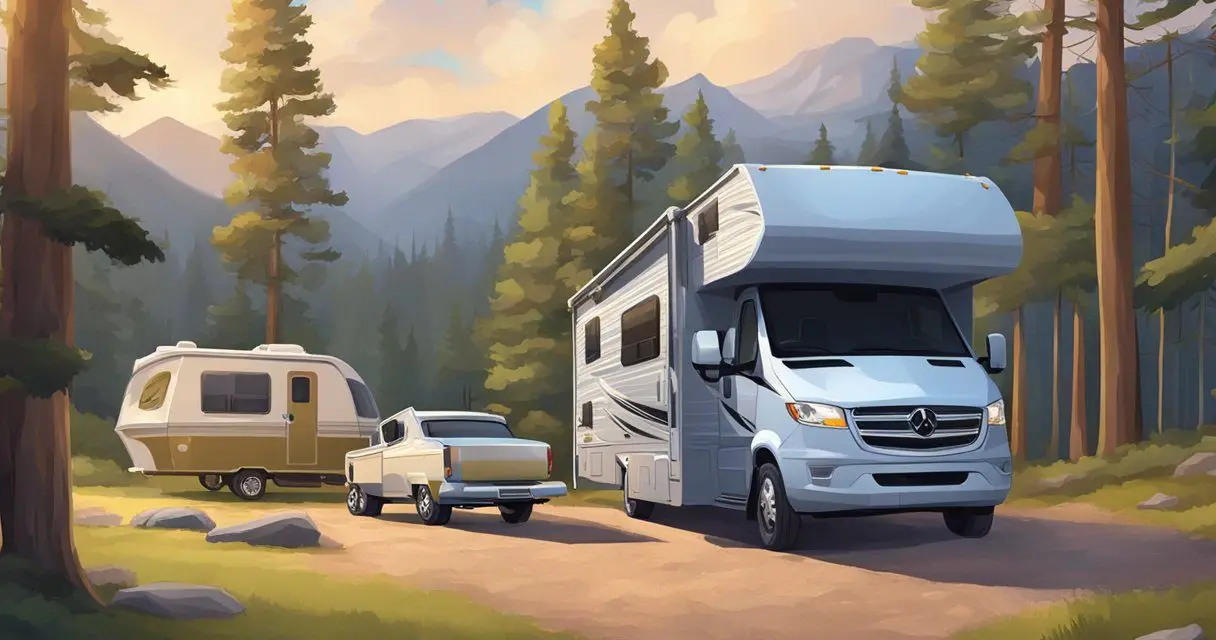Would you like to save this article?
Flat towing a vehicle behind an RV opens up a world of convenience for road trip enthusiasts. It allows travelers to explore their destinations freely without the hassle of unhitching a trailer or navigating a large motorhome through tight city streets. The key to successful flat towing lies in choosing the right vehicle that’s designed for this purpose.
When selecting a car to tow behind an RV, factors like weight, transmission type, and manufacturer approval come into play. Not all vehicles are suitable for flat towing, so it’s crucial to do thorough research before making a decision. This article will explore five top choices for flat towing, helping RV owners make an informed decision for their next adventure companion.
Understanding Flat Towing
Flat towing, also known as four-down towing, is a popular method for RV enthusiasts to bring along a vehicle on their trips. This approach allows for convenient travel and exploration once at a destination.
What Is Flat Towing?
Flat towing involves pulling a vehicle behind an RV with all four wheels on the ground. This method requires a tow bar to connect the RV and the towed vehicle, often called a “toad” or “dinghy.”
The towed vehicle’s transmission must be in neutral, and its steering wheel unlocked. Some vehicles need additional equipment or modifications to be flat towed safely.
Not all cars are suitable for flat towing. RV owners must check their vehicle’s owner manual or consult with a professional to ensure compatibility.
Benefits of Flat Towing
Flat towing offers several advantages for RV travelers. It eliminates the need for a trailer, reducing overall weight and improving fuel efficiency.
This method allows for easy setup and detachment, saving time at campsites. Flat-towed vehicles can be quickly disconnected for local trips or errands.
Flat towing also preserves the towed vehicle’s mileage, as the odometer doesn’t advance while being towed. This can help maintain the car’s resale value.
Many RVers prefer flat towing for its simplicity and convenience compared to other methods like trailer towing or using a tow dolly.
Challenges in Flat Towing
Despite its benefits, flat towing comes with some challenges. Not all vehicles are flat-towable, limiting options for RV owners. Some cars require extensive modifications or additional equipment, which can be costly.
There’s a learning curve to properly connecting and disconnecting the towed vehicle. Improper setup can lead to damage or safety issues on the road.
Long-distance towing may cause wear on the towed vehicle’s components. Regular maintenance checks are crucial to ensure both the RV and toad remain in good condition.
Backing up with a flat-towed vehicle can be tricky and often requires disconnecting the toad first. This can be inconvenient in tight spaces or when navigating certain campgrounds.
1) Jeep Wrangler
The Jeep Wrangler stands out as a top choice for flat towing behind an RV. Its popularity stems from its versatility and ease of setup for towing.
All Wrangler models can be flat towed, making it a convenient option for RV enthusiasts. The vehicle’s lightweight design, ranging from 2,800 to 3,300 pounds, contributes to its towing efficiency.
Wrangler’s off-road capabilities add value for adventurers. Once at the destination, it serves as an excellent vehicle for exploring rugged terrain.
Setting up the Wrangler for flat towing is straightforward, with no special modifications required. This simplicity saves time and effort during travel preparations.
The Wrangler has no speed or distance restrictions when being towed, offering flexibility for long RV trips. Its durability ensures it can withstand the rigors of frequent towing.
Price-wise, new Wranglers range from $30,000 to $85,000, while used 2020 models typically cost between $20,000 and $30,000. This range accommodates various budgets.
For RV owners seeking a reliable, versatile, and easy-to-tow vehicle, the Jeep Wrangler proves to be an excellent choice. Its combination of features makes it a favorite among flat-towing enthusiasts.
2) Ford Escape
The Ford Escape offers flat towing capabilities, but with some important caveats. Only hybrid models of the Escape can be flat towed behind an RV.
This limitation applies to Escape Hybrids from 2020 onwards. Earlier generations of the Escape Hybrid, specifically those from 2006 to 2012, are also compatible with flat towing.
For non-hybrid Escapes, flat towing options are more limited. Models from 2004 to 2013 equipped with manual transmissions can be flat towed.
The Escape’s compact size makes it an attractive option for RV owners looking for a versatile vehicle to bring along on trips. Its hybrid powertrain provides good fuel economy for local exploration once at the destination.
When properly set up for flat towing, the Escape can be a convenient companion for RV travelers. However, it’s crucial to consult the owner’s manual and follow Ford’s specific guidelines for flat towing to ensure safe operation.
3) Chevrolet Colorado
The Chevrolet Colorado has become a popular choice for RV enthusiasts looking to flat tow a vehicle. This mid-size pickup truck offers a good balance of utility and maneuverability.
The 4-wheel-drive version of the Colorado can be flat towed when equipped with a neutral and 4WD low setting. This makes it compatible with both Class A and Class C motorhomes.
With a base weight ranging from 3,985 to 4,435 pounds, the Colorado is relatively manageable for flat towing. It also boasts its own towing capacity of 3,500 pounds, adding versatility to your travel setup.
The Colorado is particularly appealing for those who want truck capabilities without the bulk of a full-size pickup. It’s family-friendly and provides ample space for gear and supplies.
Recent models (2015-2024) of the Colorado are especially well-suited for flat towing. They offer improved features and performance compared to older versions.
When considering the Colorado for flat towing, it’s crucial to verify that your specific model is compatible. Always consult the owner’s manual and follow proper procedures to ensure safe towing.
4) Honda CR-V
The Honda CR-V has long been a favorite for RV enthusiasts looking to flat tow a vehicle. Its compact size and versatility make it an ideal companion for road trips.
Older CR-V models, specifically those from 1995 to 2014, are particularly well-suited for flat towing. These vehicles can be safely towed with all four wheels on the ground behind an RV.
The CR-V’s lightweight design contributes to its ease of towing. This means less strain on the RV and better fuel efficiency during travel.
Inside, the CR-V offers comfortable seating for four adults and ample cargo space. This extra storage can be a big plus for RV travelers who need more room for gear or supplies.
It’s important to note that Honda stopped making flat-towable CR-Vs after 2014. Those interested in this option will need to look for used models from 2014 or earlier.
When flat towing a CR-V, owners should follow Honda’s guidelines. This includes not exceeding 65 mph and taking the vehicle out of tow mode every 8 hours for a brief run.
5) GMC Sierra 1500
The GMC Sierra 1500 is a popular choice for RV enthusiasts looking to flat tow a vehicle. This versatile pickup truck offers a great balance of power and practicality for travelers on the road.
Many Sierra 1500 models from recent years can be flat towed, making it a convenient option for RV owners. The truck’s robust build and impressive towing capacity allow it to handle the rigors of being towed behind a motorhome.
One of the key advantages of flat towing a Sierra 1500 is the additional cargo space it provides. RVers can use the truck bed to transport extra gear, supplies, or recreational equipment.
The Sierra 1500 also serves as a comfortable and capable vehicle for exploring destinations once the RV is parked. Its spacious cabin and smooth ride make it ideal for day trips or running errands.
Before flat towing any vehicle, owners should consult their specific model’s manual and follow proper procedures. This ensures safe towing and prevents damage to the truck’s transmission or other components.





